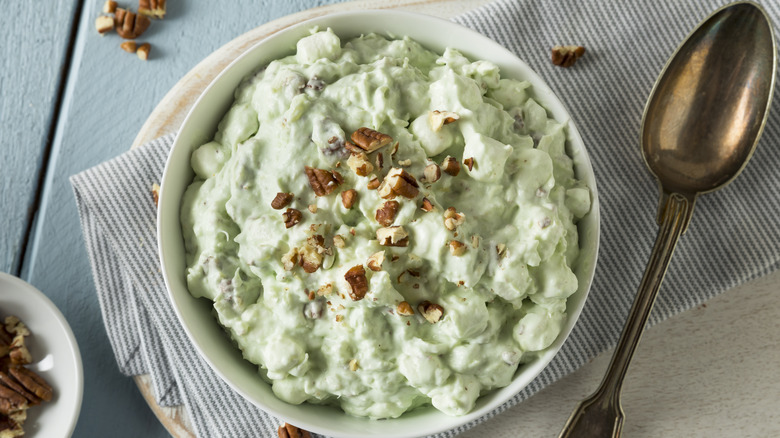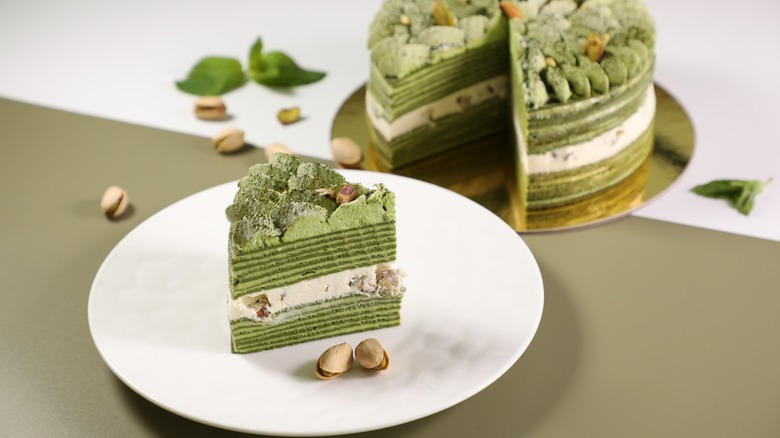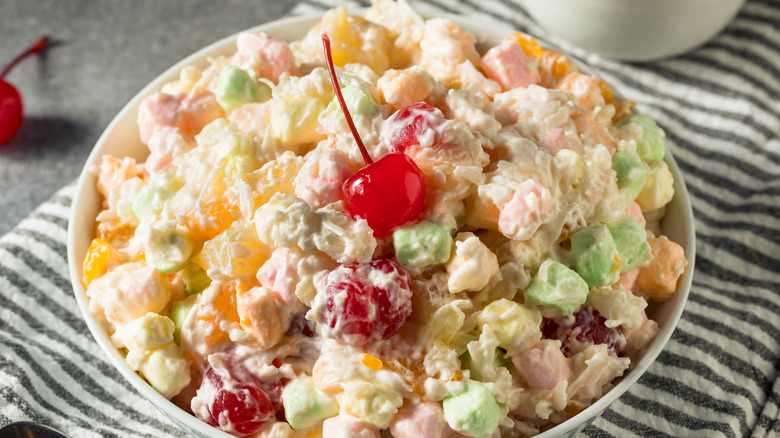Watergate Salad Is The Sweet Treat That Kicks Lettuce To The Curb
Watergate salad may not be the leafy accompaniment for your holiday menu. Still, it's a vintage classic that'll invoke nostalgia in those who grew up in the 1970s and come as a sweet surprise to younger eaters who might otherwise turn their noses up at the mention of the word "salad." Its minty color will also add some green to your table, and with a name like Watergate, it's a definite conversation starter.
Made using a combination of pistachio pudding mix, Cool Whip, mini-marshmallows, and roasted pecans, this sweet "salad" is not just for those with a penchant for political intrigue and a sweet tooth. The recipe is ready in minutes and fits in as a main course side dish as easily as on the dessert cart. Each of its handful of ingredients can be adjusted to suit the palates of those eating and where you want to place it on your menu. However, the history of its origin, to say nothing of the name, is as convoluted as the dish is simple; and whether you're eating it or not, if it's on the dinner table, you will be talking about it.
The tangled origins of Watergate salad and its name
While there's no doubt that the name "Watergate" was attached to the name of this sweet salad a few years after the political scandal with the same name, the dish's origins go back much further. Its recipe, at least in its modern form, drew from the rising popularity at the time of gelatin-containing sweet treats like Jell-O and marshmallows — two of the dish's main ingredients. Precursors to the Watergate salad, formerly pineapple pistachio delight, were desserts made with fruits and whipped cream, like Helen Keller's Golden Gate Salad from 1925.
Such desserts, usually called "delights," "salads," or even "fluff" for their airy whipped cream texture, were a potluck staple. When Jell-O introduced a pistachio pudding mix in the mid-1970s, it fell neatly into the ingredient list of these fruit and cream desserts, resulting in an early version of what would become Watergate salad.
Another source of inspiration could be the Watergate cake, made with pistachio, pecan, and coconut. Where the cake got its name is also unclear. However, a newspaper article (via History Facts) published a month after President Nixon's resignation quoted a home cook speculating that Watergate cake got its name "because of all the nuts in it!" Another tongue-in-cheek hypothesis pointed to the cake's frosted top, saying it, too, had a cover-up. While it remains open to (entertaining) discussion where the Watergate salad and cake got their names, their recipes are steeped in vintage sweet treats.
Watergate salad variations
The blend of marshmallows, Jell-O, and Cool Whip, or close substitutes of these, made Watergate salad a popular dish when novelty was associated with these ingredients. Now, you may want to spruce up the original recipe, and because of its simplicity, this dish gracefully obliges to tweaks and modifications.
The original recipe calls for undrained canned pineapple, but you can also substitute it with fresh pineapple to give the dish added freshness. However, add some sugar syrup or pineapple juice to adjust the sweetness. Many iterations also include maraschino cherries as toppings. And why limit yourself to toasted pecans when you can complement the pistachio-flavored Jell-O that the recipe calls for with freshly toasted pistachios? While on the subject of adding texture, toasted almonds and even a light sprinkle of crunchy granola work wonderfully at contrasting the fluffy cream and marshmallows.
If you're looking for a more ambitious recipe overhaul, you can take inspiration from holiday-staple fruit salads like ambrosia, which combines fruits, marshmallows and whipped cream. Try using different types of canned and fresh fruit and fruit-flavored marshmallows to mix things up further. Who knows, you might just come up with a combination that deserves its own quirky, tongue-in-cheek name.


